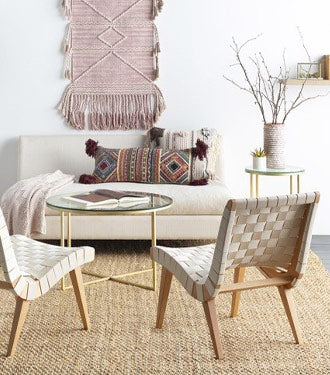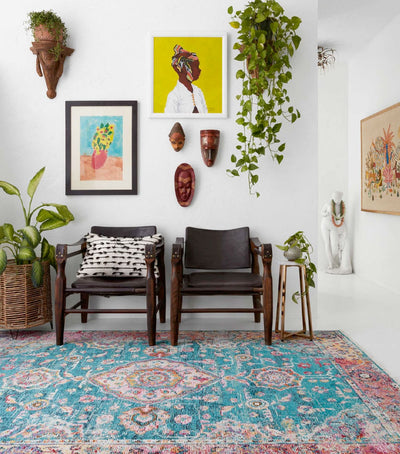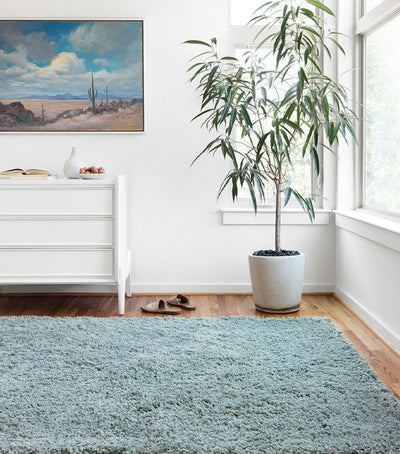Blog posts

How to Keep Rugs from Sliding
Now that you’ve picked the perfect rug for your space, you’ll want to make sure your rug stays right where you put it! Bunching, curling, slipping and sliding are annoying and even dangerous. Here are some great ways to keep rugs from sliding:
RUG PAD
A high quality non slip rug pad is the best place to start when you’re looking to keep your rug in one place...even on carpet! Rug pads vary in thickness and durability, and can be trimmed to fit any size rug. They help to reduce noise and absorb shock.
CARPET TAPE
Double sided carpet tape can be a good solution to keep rugs from sliding. The tape is applied to the rug and then stuck in place to the carpet. It is not recommended for hardwood floors or rugs that already have a rubber backing. Also, be careful about putting anything adhesive on hand knotted or antique rugs as the tape can pull at the fibers and eventually damage the rug.
SILICONE CAULKING OR HOT GLUE
If you search online for “How to Keep Rugs from Sliding” you may find recommendations for using silicone caulking or hot glue on the bottom of rugs. The adhesive is applied to the bottom of the rug, then allowed to dry completely. The dried glue is grippy, keeping the rug in place. However, it’s risky to put anything adhesive on the bottom of your rug. It can pull at the fibers, damaging the rug. And when walked on repeatedly, the dried glue or caulking can leave a residue on your flooring.
Now that we’ve walked through some of the most common ways to keep your rug from sliding, you can rest assured knowing that your new rug will stay in place.

How to Get Bumps Out of Rugs
Do you have a bump that keeps reappearing no matter how many times you smooth your rug out? Do the corners of your rug curl up, making a booby trap for anyone walking by? Maybe you just moved the furniture around and now you have bothersome little dents all over your rug. Wrinkles, bumps and dents are common with any rug. While annoying, these simple tricks can do the job and your rug will be obediently laying flat in no time.
Bumps in a rug occur when the fibers and yarns of the foundation are stretched or bent. To remove the bump, the fibers have to relax and return to their natural shape. There are a few ways to do this:
REVERSE ROLL THE RUG
Gently turn the rug face down and reverse roll it. Leave the rug rolled up for a day or two. When you unroll the rug it should lay much flatter. If you hear any cracking sound when you’re rolling the rug, STOP to avoid damaging the rug and try a different method.
USE WEIGHT
Place heavy items such as books or plants on the curled or bumpy parts of your rug. The weight will help the bent fibers to relax.
LET THE SUN SHINE
Turn the rug upside down and place it in the sun for a few hours. The heat and light will help the yarns to soften so they are more pliable.
USE STEAM POWER
A steam cleaner pushes steam into the fibers of the rug. The fibers will absorb the moisture, helping them to return to their normal shape. A professional steam cleaner can do the trick. If you have a steam cleaner at home, carefully test a corner of the rug to make sure the colors don’t run. Then run the steamer over the rippled part of the carpet several times until the fibers loosen up and lie down flat.
NOTE: HEAT SHOULD NOT BE APPLIED TO A SYNTHETIC FIBER RUG AS IT CAN CAUSE IT TO MELT.
IRON IT
If you don’t have a steamer at home, you can try using an iron. Again, it’s important to test this method on a small corner of the carpet. Place a damp towel over the bump in the rug. Turn your iron to the Steam setting. Quickly iron over the bump in short bursts. Keep the iron moving to avoid burning the fibers.
STRETCH IT OUT
A final option to try is to take the rug to a rug or carpet store to have it stretched. Professionals will slowly stretch your rug to smooth the fibers and help them return to the desired shape.
STICK IT DOWN
Once you’ve removed bumps, curls, and wrinkles, you can help prevent them from reforming by using double sided carpet tape. Apply the tape to the back of the rug, especially in places where there were bumps. This tape is made to work on carpet, tile and hardwood floors.
COOL IT
To remove dents in carpet and rugs from heavy furniture, place an ice cube on the dent overnight. As the ice cube melts, the fibers will slowly absorb the moisture, helping them to return to their original form. In the morning, remove the excess water and fluff the fibers with the edge of a spoon.
RUG PAD
To prevent bumps, wrinkles, dents and curling use a high quality rug pad under your rug. Rug pads help to avoid stretching and folding by keeping the rug in place.
Now that we’ve walked through some of the most common ways to get bumps out of your rug, enjoy your new bump-free rug for years to come!

How to Clean A Rug
Rugs are an essential design element that have the power to transform a room. But from foot traffic to pets, food spills, stains, dirt and water, your beloved rug can take a beating. When it’s time to clean your favorite rug follow the proper steps to ensure your rug lasts for years. Below are multiple methods on how to clean a rug. If these methods don't get the job done, we recommend contacting a professional rug cleaner.
BEFORE YOU CLEAN YOUR RUG
- Check the care label: First things first, read the care label that comes on your rug to know if the rug has any special instructions for cleaning. Antique, Persian, and other delicate fiber rugs should be left to the professionals. These rugs are expensive and sometimes impossible to replace and so it is worth it to invest in cleaning by a rug expert.
- Know when to clean: All rugs, no matter the material, are made to live on the floor. Most can be kept looking good with frequent vacuuming and spot cleaning as needed. But eventually your rug may need a little more. When your rug starts to look worn or simply starts to smell a little funky, it’s probably time to clean the rug.
- Shake it out: Start by taking the rug outside and giving it a really good shake. You can even use the old fashioned method of hanging up the rug and hitting it with a broom or racquet. This helps to remove dust and dirt that has been lodged into the fibers of the rug. This especially works well for longer pile rugs (think shag) as vacuums have a hard time pulling dirt from between the fibers.
- Vacuum both sides: Once you’ve given the rug a good shake, vacuum both sides of the rug to remove any remaining dust and dirt.
HOW TO WASH RUGS
If your rug can handle a lot of moisture, you can deep clean a rug by simply throwing it in the washer. Or for larger rugs, you can use a hose, some mild dish detergent or rug cleaner, and a scrub brush. Take your rug outside on a warm sunny day, preferably with little wind. Don’t wash your rug on the grass as the soap may be harmful to plants.
- Thoroughly wet down your rug using a hose or several buckets of water. Mix a small amount of soap or rug cleaner with warm or cold water in a bucket. Don’t use hot water as it may cause your rug to shrink.
- Test the soap mixture in a small corner of the rug to be sure the soap doesn’t affect the color of the rug. Let the soap sit for a few minutes and then rinse it out thoroughly. If the color doesn’t fade or bleed then you’re safe to clean the entire rug.
- Using a soft scrub brush, lather the soap mixture into the rug. Let the soap sit on the rug for a few minutes, and then rinse it thoroughly with water. Make sure the soap is completely rinsed out and the runoff water is clear.
- Roll the rug up tight and then stand it upright for several minutes to remove excess water.
- Then lay the rug completely flat to allow the rug to dry. Once the top is dry flip the rug over to dry the bottom. This may take several days, so you may need to move the rug into a garage or large laundry room to let it dry completely. The rug will be dry when you can’t feel any moisture when you push your fingers into the rug. The fibers may be a little crunchy at first but will soften over time.
HOW TO CLEAN A RUG WITH A STEAM CLEANER
If your rug is not made to handle a lot of moisture, steam cleaning can be a great method. Steam cleaners come in a variety of sizes and can be purchased or rented. Steam cleaners work by forcing steam into carpets which loosens dirt, dust, mites, and bacteria from the fibers so they can be easily removed from the rug. Steam cleaners don’t require suction because the water from the steam quickly evaporates.
- Be sure to check the label of your rug for care instructions. Vacuum the rug thoroughly on both sides. If the rug is on a hardwood floor move the rug to a carpeted area or to a cement floor. Or, you can place a waterproof barrier under the rug (such as a tarp) to protect the flooring. Follow the instructions on the steamer to fill it with water and a small amount of mild cleaner. Turn on the steamer and allow time for the steamer to warm up. Pro tip: too much soap can ruin a rug so be sure to use only the suggested amount from your steamer instructions.
- Start at one end of the rug and pull the steamer toward you in smooth straight lines, working backward across the rug. Once the rug is cleaned you can help the rug to dry by opening windows or turning on fans. Once the top of the rug is dry, turn it over to dry the back.
HOW TO CLEAN A RUG WITH A CARPET CLEANER
Carpet cleaners clean by forcing soapy water into the rug and then immediately sucking the dirty water out. Carpet cleaners come in an assortment of sizes and can be purchased or rented. For spot cleaning and small jobs, a portable handheld carpet cleaner does the job nicely. For bigger jobs, you’ll want to get a machine that’s made to clean large carpets.
- Check the care label on your rug to be sure your rug can handle a carpet cleaner. Vacuum the rug thoroughly on both sides. If the rug is on a hardwood floor, make sure to put a waterproof barrier underneath or move it to a carpeted or cement floor. Follow the instructions on the cleaner to fill the machine with water and the proper amount of soap as too much soap can ruin carpets.
- Start at one end of the rug and pull the cleaner in smooth straight lines. Work backwards so you don’t have to step on the parts of the rug that have been cleaned. When finished, help the rug to dry quickly by opening windows or turning on fans. When the top of the rug is dry turn it over to dry the back.
HOW TO CLEAN A RUG WITH A PRESSURE WASHER
Carpet cleaners clean by forcing soapy water into the rug and then immediately sucking the dirty water out. Carpet cleaners come in an assortment of sizes and can be purchased or rented. For spot cleaning and small jobs, a portable handheld carpet cleaner does the job nicely. For bigger jobs, you’ll want to get a machine that’s made to clean large carpets.
- Power washing is not recommended for antique or natural fiber rugs (wool,
cotton, jute, sisal, leather, etc). With synthetic fiber rugs ( polyester, nylon, etc.), test a small section of the rug to be sure colors don’t run or bleed. - Use cool water to power wash the rug on a flat surface such as a driveway. Wash the rug in small lines, pushing the dirt to the edges of the rug. Once the rug is completely clean, allow it to dry thoroughly.
CLEANING RUGS BY MATERIAL
The way you clean everyday spills and stains from rugs depends upon the fabric from which the rug is woven. Here are some general guidelines:
WOOL, COTTON, ACRYLIC AND RAYON RUGS
- Blot - do not rub - any excess liquid spill before adding a cleaning solvent. Repeat: DO NOT RUB!
- Wool rugs should be cleaned with a neutral detergent and dried quickly.
- Do not use "oxy" cleaners on wool rugs. They will fade the dye in the rug.
- Be sure to quickly blot dry with a towel using pressure. Do not use heat or let it air-dry completely. This will leave an odor.
- If an all-over cleaning is require we recommend professional steam cleaning by a dedicated rug-cleaning service. Colors may show a slight change (no more than 5%) when cleaned. Darker tones are more susceptible.
- For rugs with plush piles, do not use a dry powder cleaner. The cleaning residue will be difficult to remove. Dry powder cleaners are OK to use on surface stains on low pile rugs.
- Do not use laundry detergents to clean wool rugs. The laundry detergent will leave a residue and alter color shades.
SYNTHETIC RUGS - OLEFIN, NYLON, RAYON
- Synthetic rugs should be cleaned with a neutral detergent and dried quickly.
- It is OK to use “oxy” cleaners on synthetic rugs. Be sure to carefully follow the cleaner's instructions.
- Do not use laundry detergents to clean synthetic rugs. The laundry detergent will leave a residue and alter color shades.
SILK RUGS
- Should only be cleaned using a dry cleaning process.
- Consult a reputable professional.
NATURAL / PLANT FIBERS - JUTE, SISAL, SEAGRASS, COIR, HEMP
- Rugs made with natural / plant fibers should only be cleaned with a neutral detergent and dried quickly.
- Remember to dry quickly
- For liquid spills, dry both sides of your rug.
- For liquid spills with color (soft drink, juice, etc.), sprinkle baking soda or salt on the spot to absorb the color. Leave for a few minutes and then vacuum.
- Neutralize pet odors by sprinkling a mixture of 1 cup Borax and 2 cups cornmeal. Allow to stand for an hour before vacuuming. Many commercial cleaning products also work well to remove pet odors from rugs.
- We do not recommend using your vacuum's beater bar on any rug type. To get the most life out of your rug, only use the vacuum’s suction.

